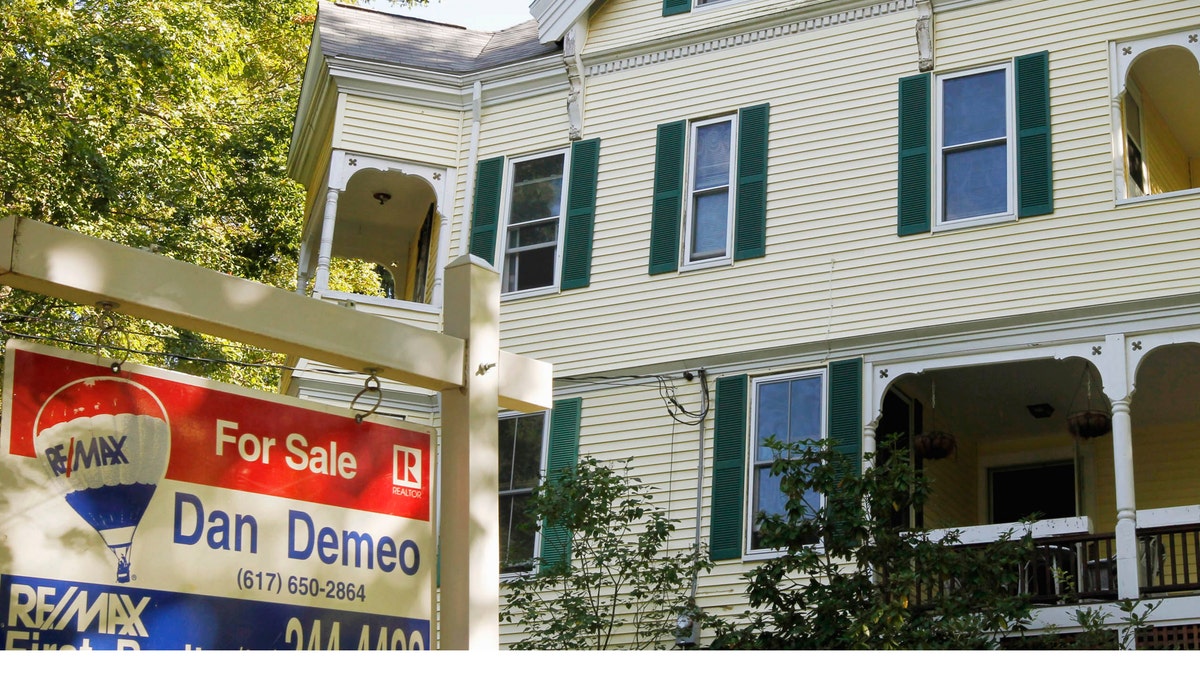
FILE - In this Sept. 19, 2011 file photo, a house with a "for sale" sign in front is seen in Newton, Mass. Home ownership over the past decade posted the biggest drop since the Great Depression as layoffs, foreclosures and the mortgage mess made it harder for people to buy or hold onto their homes. Analysts say the U.S. may never return to its mid-decade peak of roughly 7 in 10 homes owned by their occupants. (AP Photo/Steven Senne, File)
Minority homeownership in the U.S. rose slightly over the past decade, boosted by more home buying among the younger and larger Latino population.
Hispanic homeownership increased from 45.7 percent to 47.3 percent during the past 10 years, rising sharper than overall minority homeownership, which rose from 47.4 percent to 48 percent, according to new 2010 census figures released Thursday.
The minority housing numbers offered a glimmer of home in otherwise dismal statistics, which showed the biggest drop in overall American homeownership since the Great Depression.
The analysis by the Census Bureau found the homeownership rate fell to 65.1 percent last year. While that level remains the second highest decennial rate, analysts say the U.S. may never return to its mid-decade housing boom peak in which nearly 70 percent of occupied households were owned by their residents.
The reason: a longer-term economic reality of tighter credit, prolonged job losses and reduced government involvement.
Blacks, who as a whole have lower income and higher unemployment than other groups, were particularly set back by the housing bust. Their homeownership rate fell from 46.3 percent in 2000 to 44.3 percent; among whites, the rate dipped slightly from 72.4 percent to 72.2 percent. Whites are now on average 1.63 times more likely than blacks to own a home, the widest gap since 1960.
In all, nearly 44 percent of all renters in the U.S. are minorities, compared with only 22 percent of homeowners. Broken down by state, minorities make up more than half of all renters in 10 states and the District of Columbia, up from 6 in 2000 — with the new states being New York, New Jersey, Mississippi, Louisiana and New Mexico.
"There is no doubt that a large part of the white-minority economic divide is reflected in the disproportionate minority representation among the nation's renters," said William H. Frey, a demographer at Brookings Institution, who analyzed the race data. "The recent financial crises, including large numbers of subprime loans to African Americans, has dramatically widened the white-black homeownership disparity."
Unemployed young adults are least likely to own, delaying first-time home purchases to live with Mom and Dad. Middle-aged adults 35-64, mostly homeowners who were hit with mortgage foreclosures or bankruptcy after the housing bust in 2006, are at their lowest levels of ownership in decades.
Measured by race, the homeownership gap between whites and blacks is now at its widest since 1960, wiping out more than 40 years of gains.
"The changes now taking place are mind-boggling: the housing market has completely crashed and attitudes toward housing are shifting from owning to renting," said Patrick Newport, economist with IHS Global Insight. "While 10 years ago owning a home was the American Dream, I'm not sure a lot of people still think that way."
He noted the now-diminished roles of mortgage buyers Fannie Mae and Freddie Mac, which for decades at the urging of government helped enable loans to borrowers with poor credit, many of them minorities. In a shift, the Obama administration earlier this year said it would move from a longtime government focus on promoting homeownership for all and instead steer people with low incomes toward renting where appropriate.
Congress has been considering whether to eliminate the federal tax deduction for home-mortgage interest, a popular incentive to home-buying that's been in place since the early 20th century.
Given depressed housing values that could continue for at least another four to five years, it now makes more sense in most cases to rent than own, Newport said.
Nationwide, the homeownership rate fell to 65.1 percent — or 76 million occupied housing units that were owned by their residents — from 66.2 percent in 2000. That drop-off of 1.1 percentage points is the largest since 1940, when homeownership plummeted 4.2 percentage points during the Great Depression to a low of 43.6 percent.
Since 1940, the number of Americans owning homes had steadily increased in each decennial census due to a mostly booming economy, favorable tax laws and easier financing. The one exception had been 1980-1990, when ownership remained unchanged at 64.2 percent.
Broken down by state, 41 states saw declines in home ownership since 2000, many of them in the South and West where foreclosures were more common. They were led by South Carolina, Alabama, Florida, Mississippi and North Carolina. On the other end of the scale, states with higher shares of vacation homes owned by affluent baby boomers saw small increases in ownership, including New Hampshire, Hawaii, Alaska and Vermont.
The U.S. housing crisis is far worse than the experience in most Western industrialized nations, which, unlike the U.S., did not foster markets of subprime lending to promote homeownership. The U.S. continues to maintain a relatively high rate of homeownership, surpassed only by countries such as Spain, Ireland, Australia and England.
"In the U.S., there's still a strong cultural pull toward homeownership, because in normal times it's always been seen as a way to build net worth and equity," said Dan McCue, research manager at Harvard's Joint Center for Housing Studies. But with many former homeowners now renting, he said, clearly that dynamic has changed: "It puts a renewed focus on rentals, and on ways to create new opportunities for low-income households to build their wealth."
Based on reporting by The Associated Press.
Follow us on twitter.com/foxnewslatino
Like us at facebook.com/foxnewslatino
